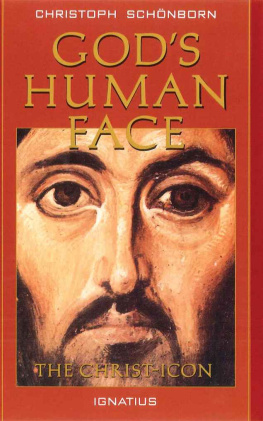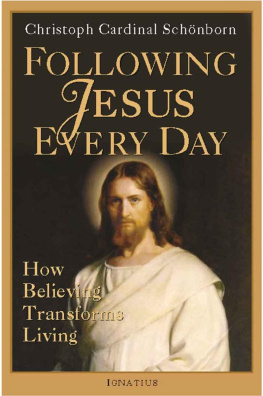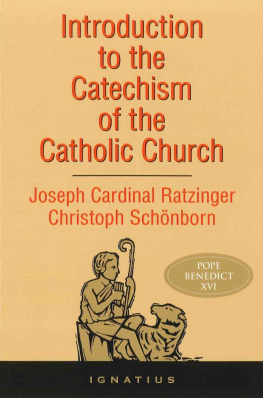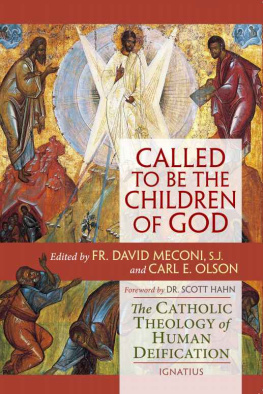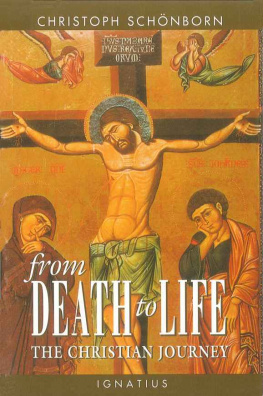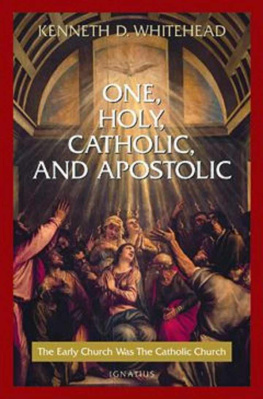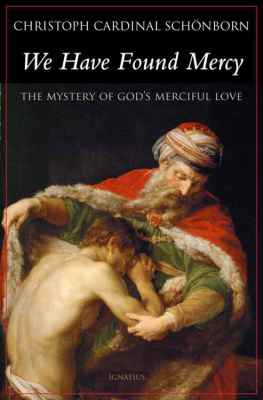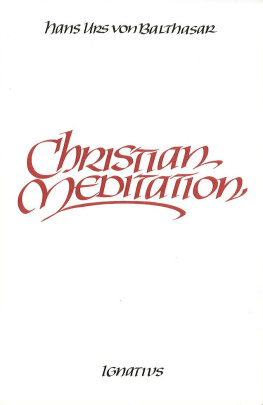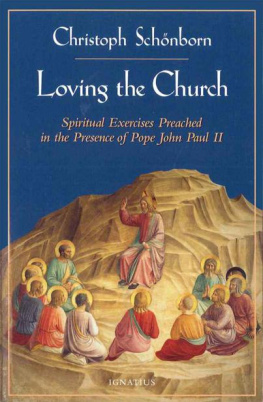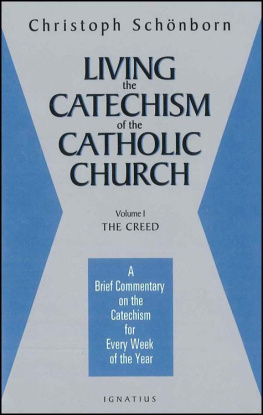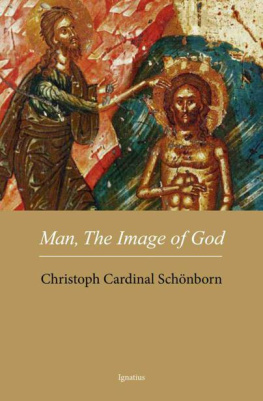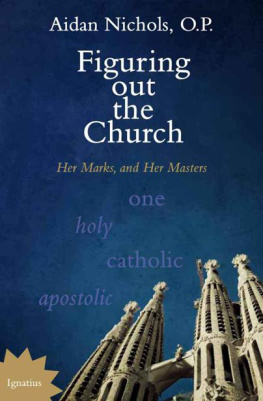GODS HUMAN FACE
CHRISTOPH SCHNBORN, O.P.
Gods Human Face
The Christ-Icon
Translated by Lothar Krauth
IGNATIUS PRESS SAN FRANCISCO
Originally published as LIcne du Christ. Fondements thologiques labors entre le Ier et le IIe Concile de Nice (325787 A.D. ), Editions Universitaires, 2nd ed. (Fribourg, 1976, 1978); Coll. Paradosis XXIV. This translation was made from the German edition, Die Christus-Ikone. Eine theologische Hinfuhrung (Schaffliausen, Germany: Novalis Verlag, 1984).
Cover design by Roxanne Mei Lum
Cover illustration: Christ the Pantocrator
Encaustic icon, 6th century (detail)
Photo by J. Galley-Schwitter A. G. (Basel)
1994 Ignatius Press
All rights reserved
ISBN 0-89870-514-2 (PB)
ISBN 978-1-68149-212-4 (EB)
Library of Congress catalogue number 94-75957
Printed in the United States of America
In memory of
Father Marie-Joseph Le Guillou, O.P.
(19201990 )
whose help and fraternal guidance
made this work possible
CONTENTS
PART ONE: THE THEOLOGICAL FOUNDATIONS
OF THE ICON
1. The Place of Images in the System of Arius
2. Athanasius: The Word as Consubstantial Image
1. The hypostasis Controversy
2. Nature and Person
a. The philological approach to ousia and hypostasis
b. A theological approach to personhood
c. The Person of the Son as the icon of the Father
d. Person and countenance ( hypostasis and prospon )
1. Generation and Subordination
2. The Divine Persons and Their Mode of Existence
3. Obedience and Freedom
1. Eusebius Letter to the Empress ConstantiaA Theological Blueprint of Iconoclasm
2. The Image of GodIndicating the Subordination of the Logos
3. The Universal Activity of the Logos
4. The Icon of Christ and Anthropology
5. Eusebius Sacramental Conception of the Image
1. The Glory of God Shining on the Face of Christ (2 Cor 4:6)
2. Whoever Sees Me, Sees the Father (Jn 14:9)
3. The Flesh of the Word
1. Nature and PersonA Detailed Analysis of Their Correlation
2. The Composite Hypostasis
3. A New Mode of Existence
4. The Two Activities and Wills in Christ
5. Christ, the Living Icon of Love
6. Image and Symbol of Himself
7. Summary and Perspective
PART TWO: THE ICON OF CHRIST AND
THE IMAGE CONTROVERSY
Chapter One: The Theological Outline of
the Byzantine Iconoclastic Controversy
1. Abuses in the Cult of Images
2. Thou Shalt Not Fashion for Thyself an Image (Ex 20:4)
3. Matter and Spirit
4. The Consubstantial Image
5. An Origenian Approach
1. The Emperor Constantine V
a. The union of the two natures in Christ
b. The concept of the image
c. The icon of Christ
2. The Synod of 754 A.D.
a. The union of the two natures in Christ
b. A hidden error
1. The Icon as Representation of Christs Flesh: Germanus of Constantinople
2. The Struggle of the Monks: George Cyprius
3. The Icon as Grace-Filled Matter: John Damascene
1. The Patriarch Nicephorus of Constantinople (750829 A.D.)
a. To circumscribe and to paintclarifying the concepts
b. The image as a relation of similarity
c. The christological realism of St. Nicephorus
d. A defective Christology?
2. The Abbot Theodore the Studite (759-826 A.D.)
a. The icon: image of the person
b. The icon: location of a personal presence
c. Seeing with physical or spiritual eyes?
d. The icon: the seal of Gods self-humiliation
ABBREVIATIONS
BKV Bibliothek der Kirchenvter (Kempten and Munich, 1913ff.).
CC Origen, Contra Celsum,
CM Eusebius of Caesarea, Contra Marcellum, GCS Eusebius Werke, vol. 6.
CSCO Corpus Scriptorum Christianorum Orientalium
DE Eusebius of Caesarea, Demonstratio evangelica, vol. 6.
DS Henricus Denzinger and Adolfus Schnmetzer, S.J., Enchiridion Symbolorum (Barcelona, Freiburg, Rome: Herder, 1976).
ET Eusebius of Caesarea, De Ecclesiastica Theologia, vol. 6
GCS Griechische Christliche Schriftstetler der ersten drei Jahrhunderte (Leipzig and Berlin, 1897ff.).
HE Eusebius of Caesarea, Historia Ecclesiastica, vol. 2.
JTS Journal of Theological Studies , new series (1949ff.).
LC Eusebius of Caesarea, Laus Constantini, vol. 1.
Mansi J. D. Mansi, Sanctorum conciliorum nova et amplissima collectio (Florence, 1759ff.).
PA Origen, Peri Archn.
PE Eusebius of Caesarea, Praeparatio Evangelica, vol. 8.
PG J. P. Migne, ed., Patrologiae cursus, series graeca (Paris, 1857ff.).
PL J. P. Migne, ed., Patrologiae cursus, series latitta (Paris, 1844ff.).
SC Sources chretiennes (Paris, 19411F.).
Thgr Eusebius of Caesarea, Theophania, Greek fragments, vol. 3.
Ths Eusebius of Caesarea, Theophania, Syrian translation, vol. 3.
TRE Theologische Realenzyklopdie (Berlin and New York, 1977ff.).
ZKG Zeitschrift fur Kirchengeschichte
PREFACE
TO THE 1984 EDITION
Another book on icons? Yes, and No! This book deals from beginning to end with icons, and yet icons as such are given relatively little specific attention. The topic of this book concerns those foundations without which there would be no icons, and without which the entire meaning of icons could not truly be grasped: the theological, and more precisely, the christological foundations.
There exist numerous historical studies on the artistic aspect of the icons. Yet the basic idea on which iconographic art primarily is built has seldom been studied: the Christian doctrine of the Incarnation of God , God has taken on a human face, and this face is the privileged venue of his revelation. This conviction nourishes the art of the icon, not only in its subject matter but even in its very own and distinct technique. This is the mystery it wants to express. The fascination still surrounding iconic art even in our own day may well be rooted here.
This book, written in French [in 1973] and published [in 1976], now [in 1983] presented in a thoroughly revised German edition, owes its existence to such a fascination. It began with a totally neglected, worm-eaten, not particularly artistic or valuable icon of Christ that was given to the author rather by accident (see illustration ). It might be that the dilapidated condition of the icon contributed to the aura of mystery surrounding it. It was, above all, this face : serious and gentle, almost sad, remote and yet appealingly familiar. Always this face, in countless variations, in faithful copies made from copies of ancient icons, multiform and diverseand yet always the same face.
The history of iconographic art is primarily the ever-new story of the encounter with this face. It is repeated unceasingly and never fully achieved. It has often been said that iconographic art is stiff and sterile, because it endlessly repeats the ancient patterns. This criticism misunderstands the icon. Never is it a mere mechanical copy of its model; it is always a new encounter with the inexhaustible mystery of this face.
The human face of God : this is the topic of the present book, and to that extent, it is a book on icons. Artists and theologians have meditated on the mystery of this face, trying to depict it. The purpose of this book is to attempt to unseal the wellsprings of this meditation, as nowadays they are widely forgotten, appear strange, or are even entirely lost. These sources are first of all the Church Fathers, those great teachers of the early Church. It is in their meditations on Christ that we search for the wellsprings of the iconic art. The reader, not unlike this writer himself, will perhaps at first be somewhat baffled by the unfamiliar language, terminology, and mental framework of these ancient masters. The more the reader dares to enter in, the more he will be fascinated by the depth and vitality of patristic theology, and the more he will realize that the word of the Church Fathers is akin to the image the artists put on the icon. The christological meditation of the Church Fathers shall lead to a deeper understanding of the icon and, beyond that, inspire an encounter with him who has inspired the masters of the theological word and the sacred image.
Next page
